-
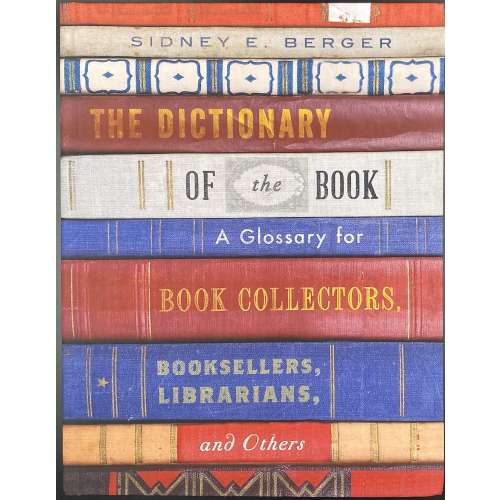 Pictorial paper hardcover, 29 x 22.5 cm, pp. [i-vi] vii-xiv, [2] 3-319 [3], total 336 pp. ISBN: 1442263393. ISBN/EAN: 9781442263390. Title-page: The Dictionary of the Book | A Glossary for Book Collectors, Booksellers, | Librarians, and Others | Sidney E. Berger | […] | Rowman & Littlefield | Lanham • Boulder • New York • London ||
Pictorial paper hardcover, 29 x 22.5 cm, pp. [i-vi] vii-xiv, [2] 3-319 [3], total 336 pp. ISBN: 1442263393. ISBN/EAN: 9781442263390. Title-page: The Dictionary of the Book | A Glossary for Book Collectors, Booksellers, | Librarians, and Others | Sidney E. Berger | […] | Rowman & Littlefield | Lanham • Boulder • New York • London || -
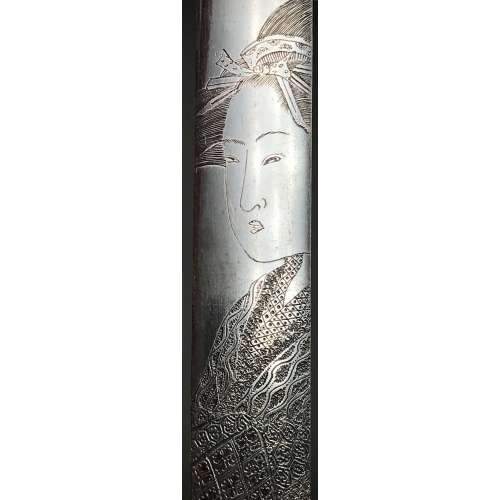 Silver Kozuka carved in kebori ("hair carving") with a ukiyo-e style half-length figure of a beautiful woman (possibly a courtesan) dressed in a splendid kimono and hair ornament (kanzashi). Signed on the back: Koreyasu/Zetai + kaō (是休「花押」) - transcribed by Markus Sesko. Size: 96.8 mm (H) x 14.9 mm (W). Edo period, early 19th century. I managed so far to find the only mention of Koreyasu at Japanese sword-mounts. A descriptive catalogue of the collection of J. C. Hawkshaw, Esq., M.A., of Hollycombe, Liphook. Complied and illustrated by Henri L. Joly. London, 1910 [LIB-1439 in this collection], page 204: 2623. — F./v., nigurome, chased in relief and inlaid with Omori Hikoshichi (large faces). Signed : Koreyasu of Yedo. xix. 2624. — F.K., nigurome, chased and inlaid in relief with Omori Hikoshichi and the witch. Signed : Shinriusha Koreyasu. No pictures of items or signature provided.
Silver Kozuka carved in kebori ("hair carving") with a ukiyo-e style half-length figure of a beautiful woman (possibly a courtesan) dressed in a splendid kimono and hair ornament (kanzashi). Signed on the back: Koreyasu/Zetai + kaō (是休「花押」) - transcribed by Markus Sesko. Size: 96.8 mm (H) x 14.9 mm (W). Edo period, early 19th century. I managed so far to find the only mention of Koreyasu at Japanese sword-mounts. A descriptive catalogue of the collection of J. C. Hawkshaw, Esq., M.A., of Hollycombe, Liphook. Complied and illustrated by Henri L. Joly. London, 1910 [LIB-1439 in this collection], page 204: 2623. — F./v., nigurome, chased in relief and inlaid with Omori Hikoshichi (large faces). Signed : Koreyasu of Yedo. xix. 2624. — F.K., nigurome, chased and inlaid in relief with Omori Hikoshichi and the witch. Signed : Shinriusha Koreyasu. No pictures of items or signature provided. -
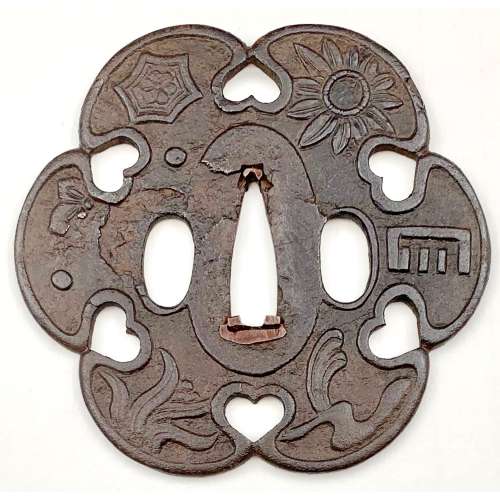 Iron tsuba of six-lobed (mutsu-mokkō-gata) form, with six wild boar's eye shape (inome) openings (sukashi). Ryo-Hitsu and the entire perimeter of tsuba have typical for this school raised rim; raised seppa dai. Lobes are decorated in low relief carving (sukidashi-bori). On the obverse: chrysanthemum, Genji mon, waves and rocks, grasses and star, bellflower, star and flower in tortoiseshell (kikko). On the reverse: Stars and different flowers, and flying geese. The plate is damaged to the left of nakago-ana and around the left hitsu-ana. Kamakura-bori school. Late Muromachi period (1514-1573). Diameter: 89 mm; Thickness at seppa-dai: 4.0 mm; Weight: 108.8 g [large]. There is a similar tsuba in this collection, TSU-0345.2018, but with a different motif and much smaller: diameter 74.3 mm, thickness at seppa-dai: 3.2 mm, weight: 62.8 g.Another look-a-like tsuba can be found at the Compton Collection, part II, pp. 14-15, №17, though his tsuba is more massive (80 x 84 x 4 mm).
Iron tsuba of six-lobed (mutsu-mokkō-gata) form, with six wild boar's eye shape (inome) openings (sukashi). Ryo-Hitsu and the entire perimeter of tsuba have typical for this school raised rim; raised seppa dai. Lobes are decorated in low relief carving (sukidashi-bori). On the obverse: chrysanthemum, Genji mon, waves and rocks, grasses and star, bellflower, star and flower in tortoiseshell (kikko). On the reverse: Stars and different flowers, and flying geese. The plate is damaged to the left of nakago-ana and around the left hitsu-ana. Kamakura-bori school. Late Muromachi period (1514-1573). Diameter: 89 mm; Thickness at seppa-dai: 4.0 mm; Weight: 108.8 g [large]. There is a similar tsuba in this collection, TSU-0345.2018, but with a different motif and much smaller: diameter 74.3 mm, thickness at seppa-dai: 3.2 mm, weight: 62.8 g.Another look-a-like tsuba can be found at the Compton Collection, part II, pp. 14-15, №17, though his tsuba is more massive (80 x 84 x 4 mm).
Varshavsky Collection: TSU-0345.2018
This tsuba, TSU-0401.2019, is the biggest of all three (another mine and the one from Campton Collection). The presence of a flower in a tortoiseshell symbol (crest or mon) on this tsuba alludes to Izumo Shrine. The overall piece, with symbols of grasses, waves, flowers, incense, stars, and flying geese, is full of autumnal connotations.
Compton Collection, part II, pp. 14-15, №17: Kamakura-bori tsuba, ca. 1450.
-
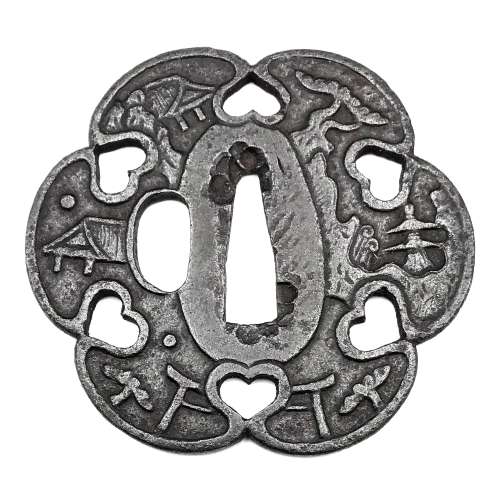 Iron tsuba of six-lobed (mutsu-mokkō-gata) form, with six wild boar's eye shape (inome) openings (sukashi). Hitsu-ana and the entire perimeter of tsuba have typical for this school raised rim. Lobes are decorated with landscape motifs in low relief carving (sukidashi-bori). On the obverse: A hut under a full moon, Shinto shrine gates (torii) with pines and a full moon, rocks, a large pine tree, and a temple (pagoda) surrounded by rocks and waves. On the reverse: waves, fishing boat, wild gees in flight under full moon, maple, hexagon (tortoiseshell, kikko) with a dot inside and a dot outside (inclusion/exclusion symbol), and chrysanthemum (the last two may be family crests, mon). Kamakura-bori school. Late Muromachi period (1514-1573). Height: 64.2 mm, width: 74.3 mm, Thickness at seppa-dai: 3.2 mm, at rim 2.6 mm. Weight: 62.8 g (light). NBTHK old green certificate №561: Tokubetsu Kicho - "Extraordinary Work". A look-a-like tsuba can be found at the Compton Collection, part II, pp. 14-15, №17, though his tsuba is more massive (80 x 84 x 4 mm).NBTHK paper says that the motif is Hakkei (八景), i.e. "Eight Views," so several interpretations are possible (the original Chinese ones, Omi Hakkei, etc.). However, most likely it is the 'Eight views of Omi' (近江八景 - 'Omi Hakkei'). Why the artist selected a 6-lobed form for depicting 8 views remains unclear, and thus we are in our right to raise the question whether the motif is indeed Hakkei. The term Omi hakkei (eight views of Omi) refers to painting or print sets which illustrate life on the shores of Lake Biwa in Omi (now Shiga Prefecture). The model for such paintings came from China, where, from the eleventh century onward, painters had produced eight views of the Hsiao and Hsiang lake areas of Hunan Province. The themes, which follow the original Chinese models, are: geese descending to land, returning fishing boats, clearing rain, a snow-covered evening landscape, the autumn moon, night rain, a temple bell at evening, and the glow of sunset. Japanese artists have also used the eight-theme approach for other parts of country - including cities - and applied it to subject matter other than landscapes. [Merrily Baird. Symbols of Japan. Thematic motifs in art and design. Rizzoli international publications, Inc., 2001, page 308-9]. Japan Encyclopedia by Louis Frédéric also mentions Omi Hakkei as "Eight landscapes of Omi", and states that this theme was often cited in poetry after 1500. It is likely that the tsuba in focus is designed under the influence of the theme popularity in the 16th century. The theme was effectively exploited by prominent ukiyo-e artists Suzuki Harunobu and Utagawa Hiroshige in the 18th and 19th century, respectively. These are the eight scenes of the theme (see Wikipedia):
Iron tsuba of six-lobed (mutsu-mokkō-gata) form, with six wild boar's eye shape (inome) openings (sukashi). Hitsu-ana and the entire perimeter of tsuba have typical for this school raised rim. Lobes are decorated with landscape motifs in low relief carving (sukidashi-bori). On the obverse: A hut under a full moon, Shinto shrine gates (torii) with pines and a full moon, rocks, a large pine tree, and a temple (pagoda) surrounded by rocks and waves. On the reverse: waves, fishing boat, wild gees in flight under full moon, maple, hexagon (tortoiseshell, kikko) with a dot inside and a dot outside (inclusion/exclusion symbol), and chrysanthemum (the last two may be family crests, mon). Kamakura-bori school. Late Muromachi period (1514-1573). Height: 64.2 mm, width: 74.3 mm, Thickness at seppa-dai: 3.2 mm, at rim 2.6 mm. Weight: 62.8 g (light). NBTHK old green certificate №561: Tokubetsu Kicho - "Extraordinary Work". A look-a-like tsuba can be found at the Compton Collection, part II, pp. 14-15, №17, though his tsuba is more massive (80 x 84 x 4 mm).NBTHK paper says that the motif is Hakkei (八景), i.e. "Eight Views," so several interpretations are possible (the original Chinese ones, Omi Hakkei, etc.). However, most likely it is the 'Eight views of Omi' (近江八景 - 'Omi Hakkei'). Why the artist selected a 6-lobed form for depicting 8 views remains unclear, and thus we are in our right to raise the question whether the motif is indeed Hakkei. The term Omi hakkei (eight views of Omi) refers to painting or print sets which illustrate life on the shores of Lake Biwa in Omi (now Shiga Prefecture). The model for such paintings came from China, where, from the eleventh century onward, painters had produced eight views of the Hsiao and Hsiang lake areas of Hunan Province. The themes, which follow the original Chinese models, are: geese descending to land, returning fishing boats, clearing rain, a snow-covered evening landscape, the autumn moon, night rain, a temple bell at evening, and the glow of sunset. Japanese artists have also used the eight-theme approach for other parts of country - including cities - and applied it to subject matter other than landscapes. [Merrily Baird. Symbols of Japan. Thematic motifs in art and design. Rizzoli international publications, Inc., 2001, page 308-9]. Japan Encyclopedia by Louis Frédéric also mentions Omi Hakkei as "Eight landscapes of Omi", and states that this theme was often cited in poetry after 1500. It is likely that the tsuba in focus is designed under the influence of the theme popularity in the 16th century. The theme was effectively exploited by prominent ukiyo-e artists Suzuki Harunobu and Utagawa Hiroshige in the 18th and 19th century, respectively. These are the eight scenes of the theme (see Wikipedia):
Compton Collection, part II, pp. 14-15, №17: Kamakura-bori tsuba, ca. 1450.
- Returning sails at Yabase (矢橋の帰帆) - Yabase. Yabase is an old harbour on the east side of the lake. Near the Tokaido, it was used for a shortcut to Otsu by boat.
- Evening glow at Seta (勢多(瀬田)の夕照) - The Chinese Bridge at Seta. The long bridge across the Seta was used by the Tokaido. In the background the "Fuji of Omi", the Mikamiyama. It is just above 400 m, but indeed well visible.
- Autumn moon at Ishiyama (石山の秋月) - Ishiyama Temple. The Ishiyamadera was located on a hillside next to the Seta River. It got his name form the strange rocks on which it is built, partly on supporting beams. A hut at the upper end of the site allows a view of the lake, and the moon.
- Clear breeze at Awazu (粟津の晴嵐) - Awazuhara. Awazu is well known for its pine wood, Awazu-ga-hara.
- Evening bell at Miidera (三井晩鐘) - Mii-dera. Miidera temple was built in the 8th century. Its famous bell is one of the "Three bells of Japan", the other two being those at Byoodo-in, Uji and at Jingoji, Kyoto.
- Evening rain at Karasaki (唐崎の夜雨) - Karasaki Shrine. Karasaki is a small cape with a single large pine tree, a hitsu-matsu.
- Wild geese returning home at Katata (堅田の落雁) - Ukimido. Alighting geese cannot be seen always, however the little temple near Katata in the square hōkyō-style, detached from the lakeside, connected by a bridge. The first part of the name uki is the same as in Ukiyo-e, meaning floating. Midō means temple.
- Evening snow at Hira (比良の暮雪) - Hira Mountains. The Hira mountains on the west side of the lake experience the hard winter, when the winter monsoon brings much snow from the continent.
-
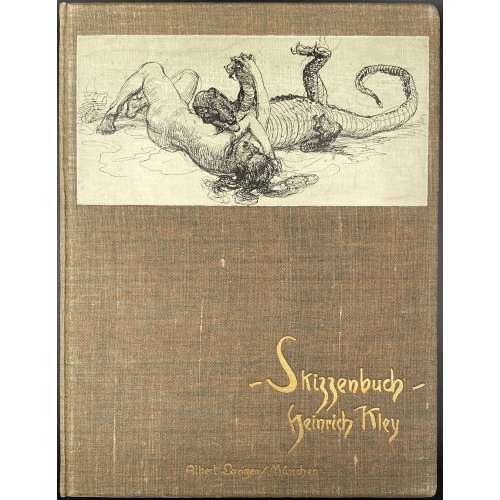
The edition consists of two albums:
1) Skizzenbuch: Hundert Federzeichnungen von Heinrich Kley. — München: Albert Langen, [1909]. — pp.: [1-4] 5-63 [64], illustr. Printed by Hesse & Becker in Leipzig. Bound in the original brown moire covered boards, with a paste-down drawing on the front, gilt cover titles, original patterned endpapers.
2) Skizzenbuch II. Hundert Federzeichnungen von Heinrich Kley. — München: Albert Langen, [1910]. — pp.: [1-4] 5-64, illustr. Printed by Hesse & Becker in Leipzig; paper by Bohnenberger & Cie.; binding by E. A. Enders, Leipzig. Bound in the original bluish-gray moire covered boards, with a paste-down drawing on the front, gilt cover titles, original patterned endpapers.
The number of printed copies unknown. Reproduction of ink drawings by Heinrich Kley, 1st edition.
Dimensions of each album: 32 x 24.5 cm; Quarto. Heinrich Kley (April 15, 1863 in Karlsruhe – 1945? in Munich) was a German illustrator, editorial illustrator and painter. -
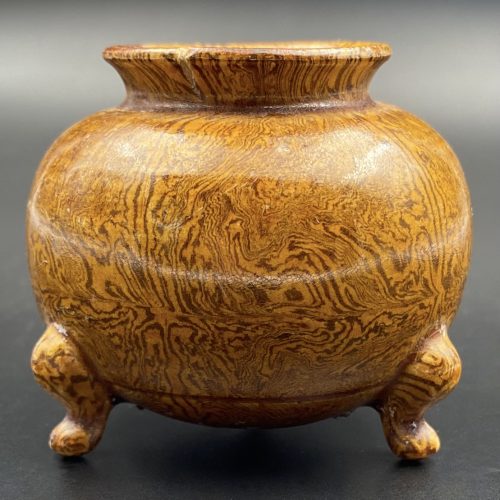 Small amber-glazed marbled (Jiaotai) pottery tripod censer. Inside the glaze is monochrome because the clay itself is not marbled. Spur marks on the bottom. Small chip on a lip. China, Henan province, the Tang dynasty [唐朝] (618 – 907). Diameter: 6.3 cm; Height: 5.5 cm.
Small amber-glazed marbled (Jiaotai) pottery tripod censer. Inside the glaze is monochrome because the clay itself is not marbled. Spur marks on the bottom. Small chip on a lip. China, Henan province, the Tang dynasty [唐朝] (618 – 907). Diameter: 6.3 cm; Height: 5.5 cm. -
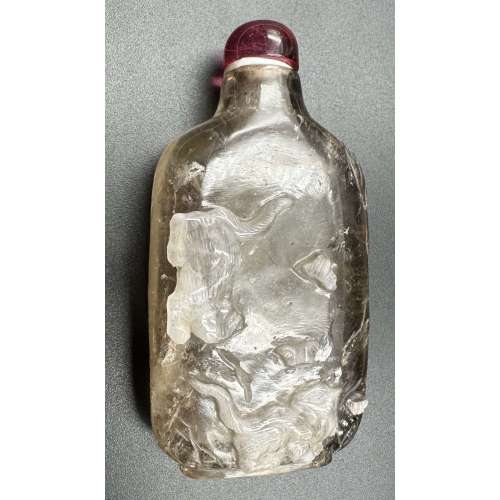 NEWSnuff bottle made of smoky quartz with white skin carved with cats hunting butterflies design; cherry quartz stopper. Late 19th century. Dimensions: H70 x W36 x D17 mm
NEWSnuff bottle made of smoky quartz with white skin carved with cats hunting butterflies design; cherry quartz stopper. Late 19th century. Dimensions: H70 x W36 x D17 mm -
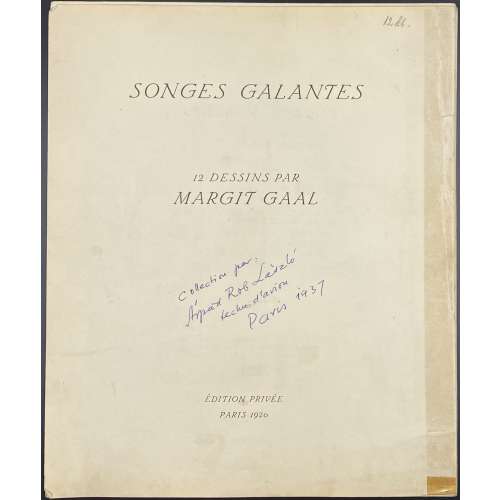 In an owner’s quarter buckram cardboard folder with a vegetation diaper design, ms blue ink lettering to front: “Songes galantes | 12 dessins par | Margit Gaal” at the centre, “Arpad Rob Laszlo | à Paris | 1938” in the lower right corner. Loose sheets with the 1st leaf t.p. / table de planches, and then 12 leaves of lithograph plates. Title-page: SONGES GALANTES | 12 DESSINS PAR | MARGIT GAAL | ÉDITION PRIVÉE | PARIS 1920 ||, ms inscription in blue ink in the middle : “Collection par | Árpad Rob Laśzló | techn. d’avion | Paris 1937”. Limitation: Edition limited to 500 copies of which № 1-100 signed by the author. This is copy № 407. References: Dutel (1920-1970) № 1413 (published in 1921); Honesterotica (indicated the year of death as 1965, however, there is no proof). Contributors: Gaál, Margit (Hungarian, 1898 – 1920) – artist.
In an owner’s quarter buckram cardboard folder with a vegetation diaper design, ms blue ink lettering to front: “Songes galantes | 12 dessins par | Margit Gaal” at the centre, “Arpad Rob Laszlo | à Paris | 1938” in the lower right corner. Loose sheets with the 1st leaf t.p. / table de planches, and then 12 leaves of lithograph plates. Title-page: SONGES GALANTES | 12 DESSINS PAR | MARGIT GAAL | ÉDITION PRIVÉE | PARIS 1920 ||, ms inscription in blue ink in the middle : “Collection par | Árpad Rob Laśzló | techn. d’avion | Paris 1937”. Limitation: Edition limited to 500 copies of which № 1-100 signed by the author. This is copy № 407. References: Dutel (1920-1970) № 1413 (published in 1921); Honesterotica (indicated the year of death as 1965, however, there is no proof). Contributors: Gaál, Margit (Hungarian, 1898 – 1920) – artist. -
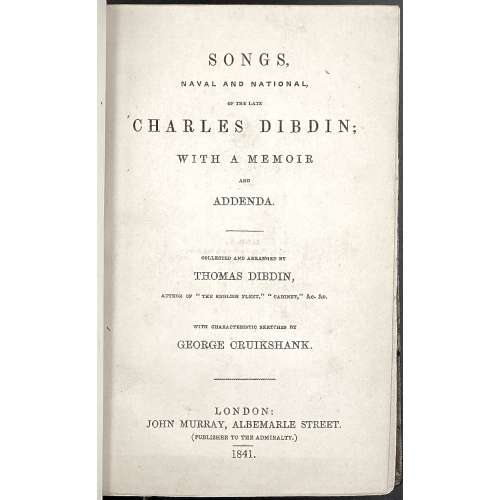 Title: SONGS, | NAVAL AND NATIONAL, | OF THE LATE | CHARLES DIBDIN; | WITH A MEMOIR | AND | ADDENDA. | COLLECTED AND ARRANGED BY | THOMAS DIBDIN, | AUTHOR OF “THE ENGLISH FLEET,” CABINET,” &c. &c. | WITH CHARACTERISTIC SKETCHES BY | GEORGE CRUIKSHANK. | LONDON: | JOHN MURRAY, ALBEMARLE STREET. | (PUBLISHED TO THE ADMIRALTY) | 1841.|| Pagination: [4 binder's blanks] [i-vi] vii-xv [xvi advert.], [1] 2-336 [4 binder's blanks], engraved frontispiece and 11 plates by George Cruikshank. Collation: 8vo; [A] – Y8. Binding: brown ¾ morocco, ruled in gilt over marbled boards, marbled endpapers, raised bands, gilt in compartments, top margin gilt, title lettering and year to spine, by V. Krafft. Bookplate to front pastedown “Ex Libris Robert Hoe”. Provenance: HOE, Robert III (American, 1839-1909) – American businessman and producer of printing press equipment. Catalogue raisonné: Albert M. Cohn (1924): № 231, p. 75. Makers: Charles Dibdin the younger (British, 1768—1833) – author. Thomas John Dibdin (British, 1771—1841) – author. William Clowes (British, 1779—1847), printer. John Murray III (British, 1808—1892), publisher. George Cruikshank (British, 1792—1878), artist, emgraver.
Title: SONGS, | NAVAL AND NATIONAL, | OF THE LATE | CHARLES DIBDIN; | WITH A MEMOIR | AND | ADDENDA. | COLLECTED AND ARRANGED BY | THOMAS DIBDIN, | AUTHOR OF “THE ENGLISH FLEET,” CABINET,” &c. &c. | WITH CHARACTERISTIC SKETCHES BY | GEORGE CRUIKSHANK. | LONDON: | JOHN MURRAY, ALBEMARLE STREET. | (PUBLISHED TO THE ADMIRALTY) | 1841.|| Pagination: [4 binder's blanks] [i-vi] vii-xv [xvi advert.], [1] 2-336 [4 binder's blanks], engraved frontispiece and 11 plates by George Cruikshank. Collation: 8vo; [A] – Y8. Binding: brown ¾ morocco, ruled in gilt over marbled boards, marbled endpapers, raised bands, gilt in compartments, top margin gilt, title lettering and year to spine, by V. Krafft. Bookplate to front pastedown “Ex Libris Robert Hoe”. Provenance: HOE, Robert III (American, 1839-1909) – American businessman and producer of printing press equipment. Catalogue raisonné: Albert M. Cohn (1924): № 231, p. 75. Makers: Charles Dibdin the younger (British, 1768—1833) – author. Thomas John Dibdin (British, 1771—1841) – author. William Clowes (British, 1779—1847), printer. John Murray III (British, 1808—1892), publisher. George Cruikshank (British, 1792—1878), artist, emgraver. -
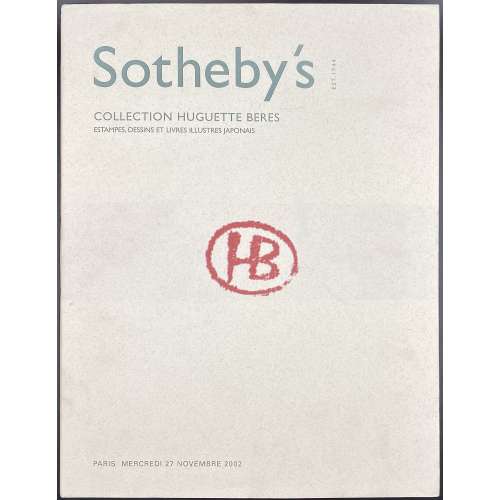 Two paperback volumes, 29.6 x 22.8 cm, pictorial softcover in full dust jacket with letering (see below); One the back DJ of both volumes lettered: “Sotheby’s | EST. 1744 (vertical) | GALERIE CHARPENTIER 76 RUE DE FAUBOURG SAINT-HONORÉ 75008 PARIS WWW. SOTHEBYS.COM”. Vol. 1: DJ lettered in olive green: Sotheby’s | EST. 1744 (vertical) | COLLECTION HUGUETTE BERES | ESTAMPES, DESSINS ET LIVRES ILLUSTRES JAPONAIS | {HB monogram in red} | PARIS MERCREDI 27 NOVEMBRE 2002 ||. Pagination: 2 ffl, [1-5] (h.t., t.p., Sommaire), 6-340, 2 ffl; 229 lots with ils.; sale PF2021 Vol. 2: DJ lettered in olive green: “Sotheby’s | EST. 1744 (vertical) | COLLECTION HUGUETTE BERES | ESTAMPES, DESSINS ET LIVRES ILLUSTRES JAPONAIS (SECONDE VENTE) | {HB monogram in red} | PARIS MARDI 25 novembre 2003 ||. Pagination: 2 ffl, [1-7] (h.t., t.p., Sommaire, f.t.) 8-287 [288 blank], 2 ffl; 252 lots with ils.; sale PF3018. Contributors: Huguette Berès (French, 1913 – 1999)
Two paperback volumes, 29.6 x 22.8 cm, pictorial softcover in full dust jacket with letering (see below); One the back DJ of both volumes lettered: “Sotheby’s | EST. 1744 (vertical) | GALERIE CHARPENTIER 76 RUE DE FAUBOURG SAINT-HONORÉ 75008 PARIS WWW. SOTHEBYS.COM”. Vol. 1: DJ lettered in olive green: Sotheby’s | EST. 1744 (vertical) | COLLECTION HUGUETTE BERES | ESTAMPES, DESSINS ET LIVRES ILLUSTRES JAPONAIS | {HB monogram in red} | PARIS MERCREDI 27 NOVEMBRE 2002 ||. Pagination: 2 ffl, [1-5] (h.t., t.p., Sommaire), 6-340, 2 ffl; 229 lots with ils.; sale PF2021 Vol. 2: DJ lettered in olive green: “Sotheby’s | EST. 1744 (vertical) | COLLECTION HUGUETTE BERES | ESTAMPES, DESSINS ET LIVRES ILLUSTRES JAPONAIS (SECONDE VENTE) | {HB monogram in red} | PARIS MARDI 25 novembre 2003 ||. Pagination: 2 ffl, [1-7] (h.t., t.p., Sommaire, f.t.) 8-287 [288 blank], 2 ffl; 252 lots with ils.; sale PF3018. Contributors: Huguette Berès (French, 1913 – 1999) -
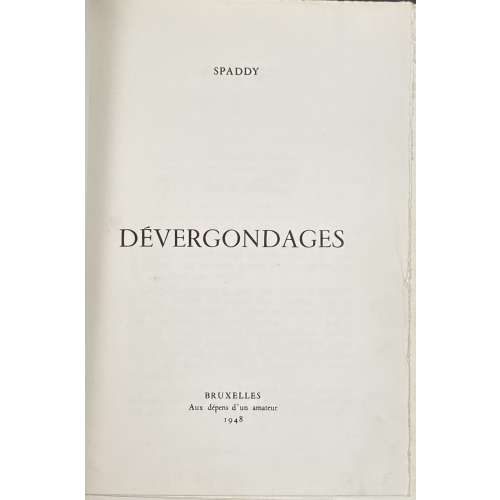 Description: single volume 24.5 x 19 cm, collated 4to, bound by a previous owner in quarter red morocco over marbled boards, raised bands, with gilt lettering in compartments: "SPADDY | DÉVERGONDAGES", red marbled endpapers. Printed on wove paper with watermark “RIVES”. Title-page: SPADDY | DÉVERGONDAGES | BRUXELLES | Aux Dépens d'un Amateur | 1948 || Pagination: [4] – blank, [1, 2] – h.t. / limitation, [3, 4] – t.p. / blank, 5-151 [152] – blank, [4] – blank; uncut, illustrated with 16 hand-coloured lithographs extraneous to collation after watercolours by Féodor Rojankowski [Rojan]. Table of contents on p. 151. Limitation: 250 copies of which №№ I – XVI with original watercolour and b/w suite of plates and №№ 17-250 on Rives paper with coloured lithography; this copy is № 100 of 234 Rives paper copies. Catalogue Raisonné: J.-P. Dutel (1920–1970) № 1389 / p. 128.
Description: single volume 24.5 x 19 cm, collated 4to, bound by a previous owner in quarter red morocco over marbled boards, raised bands, with gilt lettering in compartments: "SPADDY | DÉVERGONDAGES", red marbled endpapers. Printed on wove paper with watermark “RIVES”. Title-page: SPADDY | DÉVERGONDAGES | BRUXELLES | Aux Dépens d'un Amateur | 1948 || Pagination: [4] – blank, [1, 2] – h.t. / limitation, [3, 4] – t.p. / blank, 5-151 [152] – blank, [4] – blank; uncut, illustrated with 16 hand-coloured lithographs extraneous to collation after watercolours by Féodor Rojankowski [Rojan]. Table of contents on p. 151. Limitation: 250 copies of which №№ I – XVI with original watercolour and b/w suite of plates and №№ 17-250 on Rives paper with coloured lithography; this copy is № 100 of 234 Rives paper copies. Catalogue Raisonné: J.-P. Dutel (1920–1970) № 1389 / p. 128. -
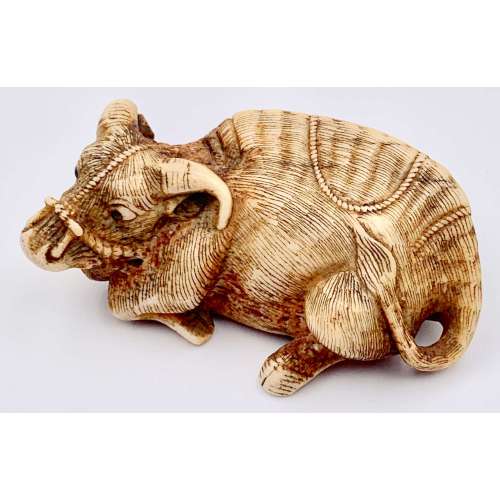 Stag antler netsuke of a recumbent ox. Signed: Tomomasa [友政]. Circa 1800. Dimensions: 56.1 x 20.7 x 36.8 mm Just speculation: There was a master in Kyoto named Tomotada who made netsuke with a recumbent ox motif. Our Tomomasa may be an epigone of a later date. Some even attribute the master to Meiji period. Provenance: Charles Ephrussi (1849-1905) acquired in the 1870s; a wedding gift in 1898 to his cousin Ritter Viktor von Ephrussi (1860-1945) and Baroness Emilie (Emmy) Schey von Koromla (1879-1938); retrieved post-war by their daughter Elizabeth de Waal (1899-1991); given by her to her brother Ignaz (Iggie) Ephrussi (1906-1994), Tokyo; bequeathed by him to his great-nephew Edmund de Waal (born 1964), London, author of “The Hare with Amber Eyes: a hidden inheritance”. London / New York: Chatto & Windus / Farrar, Straus & Giroux. ISBN 978-0099539551. https://en.wikipedia.org/wiki/Charles_Ephrussi. https://en.wikipedia.org/wiki/Ephrussi_family. https://en.wikipedia.org/wiki/Edmund_de_Waal.
Stag antler netsuke of a recumbent ox. Signed: Tomomasa [友政]. Circa 1800. Dimensions: 56.1 x 20.7 x 36.8 mm Just speculation: There was a master in Kyoto named Tomotada who made netsuke with a recumbent ox motif. Our Tomomasa may be an epigone of a later date. Some even attribute the master to Meiji period. Provenance: Charles Ephrussi (1849-1905) acquired in the 1870s; a wedding gift in 1898 to his cousin Ritter Viktor von Ephrussi (1860-1945) and Baroness Emilie (Emmy) Schey von Koromla (1879-1938); retrieved post-war by their daughter Elizabeth de Waal (1899-1991); given by her to her brother Ignaz (Iggie) Ephrussi (1906-1994), Tokyo; bequeathed by him to his great-nephew Edmund de Waal (born 1964), London, author of “The Hare with Amber Eyes: a hidden inheritance”. London / New York: Chatto & Windus / Farrar, Straus & Giroux. ISBN 978-0099539551. https://en.wikipedia.org/wiki/Charles_Ephrussi. https://en.wikipedia.org/wiki/Ephrussi_family. https://en.wikipedia.org/wiki/Edmund_de_Waal. -
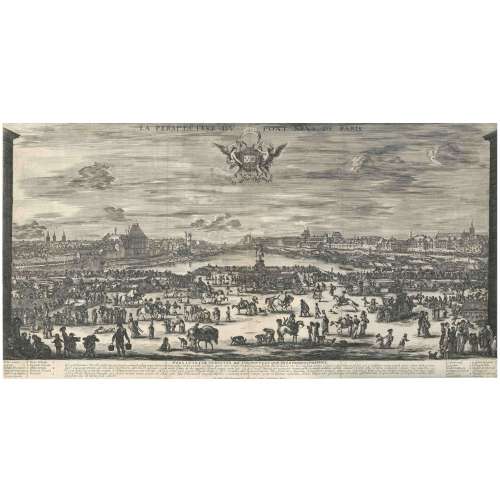
Etching on laid paper, backed. Massar (1971): 59-61. View of the Pont Neuf in Paris, with the statue of Henry IV at centre in front of the Seine, the church of St.-Germaine l'Auxerrois and the Louvre to the right, and the Hôtel de Nevers and Tour de Nesle to the left (MET). in the banner below: LUDOVICO XIIII GALLIARUM ET NAV REGI; below image: PONS LVTETIÆ STRVCTVS, DICTVS NOVVS, ET QVÆ EX EO PROSPICI POSSVNT.; bellow: En pulcherrimus toto ... caufatus, vifere; along the bottom: Ste. Della Bella Florentinus In. e Fecit DD. 1646. Cum Privilegio Regis; additional lettering a lower left and right identifying places depicted.
State: 2nd, with the weathercock on the belltower of Église Saint-Germain l'Auxerrois (under 8). Size: 35.5 x 67.6 cm. Condition: Three vertical folds, these partly cracked and backed at the bottom, dusty or slightly stained, partly slightly rubbed, a small diagonal crease on the upper left, tiny marginal blemishes.Quotation from Phyllis D. Massar. Presenting Stefano della Bella. — NY: The Metropolitan Museum of Art, [1971]: "For size and complexity, one of Della Bella's most impressive achievements is his view of Paris across the Pont Neuf from a point between the buildings bounding the Place Dauphine. Besides the well-known landmarks-the Hộtel de Nevers, the Tour de Nesle, the church of Saint Germain l'Auxerrois, and, at the centre, the bronze equestrian statue of Henri IV by the Florentines Giovanni Bologna and Pietro Tacca – the print provides a microcosm of Paris in transit across the Seine. With a glass, one can compile a census of 451 people, thirty-eight horses, nineteen dogs, three donkeys, and one lamb. All but lost in the vast scene, nevertheless, all contributing to it, are duelists, men fighting with staffs, brawlers routing passers-by, a tooth-puller making an extraction, sellers of sweetmeats and fruits, falconers, hunters with a pack of dogs, a legless cripple, many begging gypsies (one of them telling a fortune), and a hurdy-gurdy player with an audience. Moving among the splendid carriages is a humble water cart, and back among the market stands at the right is an early Seine-side bookstall."
Catalogue raisonné: Massar (1971): pp. 58-61; De Vesme p. 132, № 850ii/ii. Contributor: Stefano della Bella (Italian, 1610 – 1664) – artist and engraver. -
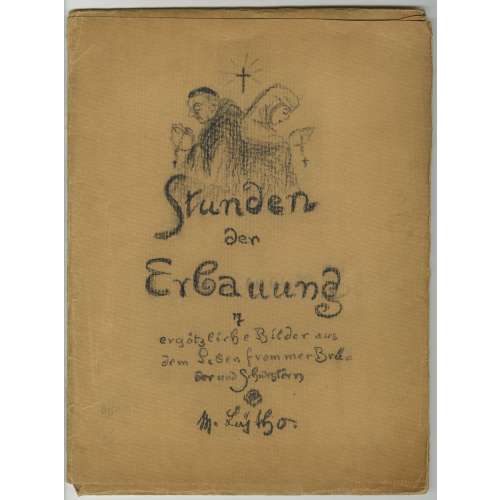 Flapped folder of thick embossed paper 353 x 263 mm, with a vignette and manuscript to front: Stunden der Erbauung | 7 | ergötz liebe Bilder aus | dem Leben frommer Brü | der und Schwestern | • | M. Leÿtho. ||, six graphite pencil drawings, each glued to a paper sheet with guard tissue; mat size 339 x 253 mm mat; drawing size 220 x 165 mm. Translation of the title: Hours of Edification / 7 delightful pictures from the lives of pious brothers and sisters. Information about the artist at www.honesterotica.com: "Mitja Leytho, almost certainly a pseudonym, is yet another mediocre yet fascinating amateur artist from the Germany of the 1920s about whom we know absolutely nothing beyond the four portfolios which bear the ‘Leytho’ signature".
Flapped folder of thick embossed paper 353 x 263 mm, with a vignette and manuscript to front: Stunden der Erbauung | 7 | ergötz liebe Bilder aus | dem Leben frommer Brü | der und Schwestern | • | M. Leÿtho. ||, six graphite pencil drawings, each glued to a paper sheet with guard tissue; mat size 339 x 253 mm mat; drawing size 220 x 165 mm. Translation of the title: Hours of Edification / 7 delightful pictures from the lives of pious brothers and sisters. Information about the artist at www.honesterotica.com: "Mitja Leytho, almost certainly a pseudonym, is yet another mediocre yet fascinating amateur artist from the Germany of the 1920s about whom we know absolutely nothing beyond the four portfolios which bear the ‘Leytho’ signature". -
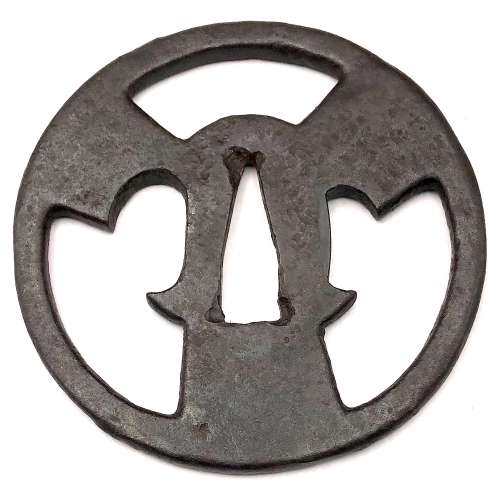 Iron tsuba of round form with three stylized folding fans motif in openwork (sukashi). Kogai-hitsu-ana with shakudō sekigane. Iron bones (tekkotsu) on the rim. Momoyama period or earlier. Possibly, Ko-Shōami school.
Iron tsuba of round form with three stylized folding fans motif in openwork (sukashi). Kogai-hitsu-ana with shakudō sekigane. Iron bones (tekkotsu) on the rim. Momoyama period or earlier. Possibly, Ko-Shōami school.Size: 76.8 x 75.7 x 4.0 mm.
[Seller alleged that the motif is "Buddhist wheel", which seems unlikely. -
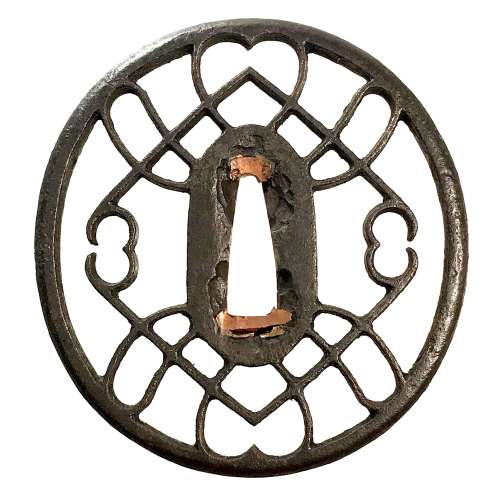 Iron tsuba of oval form with the motif of horse trappings in openwork (sukashi). Copper sekigane. Iron bones (tekkotsu) on the rim.
Iron tsuba of oval form with the motif of horse trappings in openwork (sukashi). Copper sekigane. Iron bones (tekkotsu) on the rim.Size: 80.4 x 75.8 x 5.2 mm
NBTHK Certificate №454567, allegedly saying that it is Akasaka School, Muromachi period. A look-a-like tsuba in Robert. E. Haynes Catalog #7, 1983 on page 57 under №48 is described as follows: "A masterpiece second period Owari sukashi tsuba. The plate is of beautiful color and quality almost like velvet. The design is very hard to discern, it might be the horse trappings, or even a moon. The style and type of Owari tsuba shows the great tradition of the Momoyama period and why it was the renaissance in time, as well as the arts produced, through the long history of all Japanese art. Ca. 1580. Ht. 7.7 cm, Th. (center) 5.5 mm, (edge) 5.25 to 5.75 mm."I believe we can safely attribute this tsuba to Owari School, c. 1580.
Robert. E. Haynes Catalog #7, 1983, p. 57, №48.
-
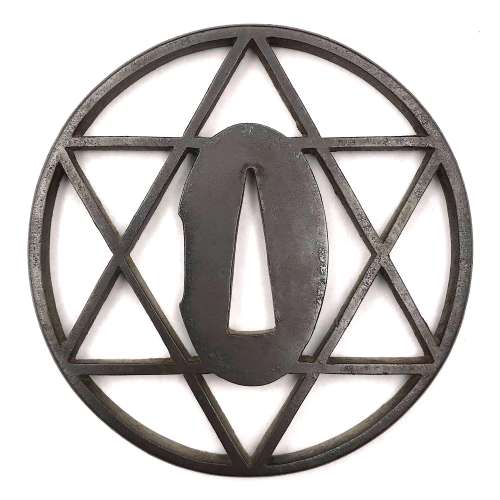 Iron tsuba of round form with two overlapping triangles (uroko) motif in openwork (sukashi). Triangle patterns usually associate with 'fish scale', mon of Hojo family (and others). Edo period or later.
Iron tsuba of round form with two overlapping triangles (uroko) motif in openwork (sukashi). Triangle patterns usually associate with 'fish scale', mon of Hojo family (and others). Edo period or later.Size: 71.4 x 70.2 x 5.2 mm.
An association with the Star of David is doubtful if not impossible. -
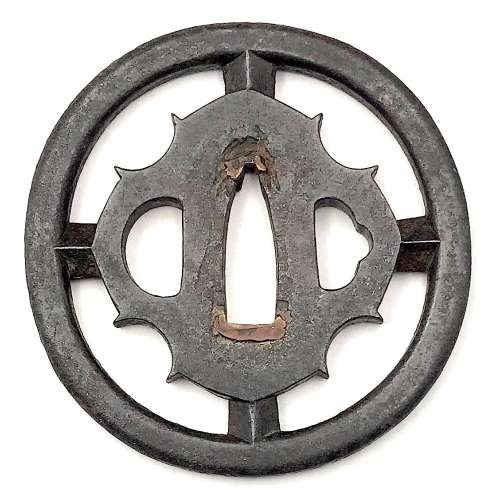 Iron tsuba of round form with slanting rays of light (shakoh) Christian motif (Jesuit's IHS symbol) in openwork (sukashi). Traditional description of this kind of design is called "tokei", or "clock gear". Edo period.
Iron tsuba of round form with slanting rays of light (shakoh) Christian motif (Jesuit's IHS symbol) in openwork (sukashi). Traditional description of this kind of design is called "tokei", or "clock gear". Edo period.Size: 77.7 x 76.1 x 6.7 mm.
For information regarding shakoh tsuba see article 'Kirishitan Ikenie Tsuba" by Fred Geyer at Kokusai Tosogu Kai; The 2nd International Convention & Exhibition, October 18-23, 2006, pp. 84-91. -
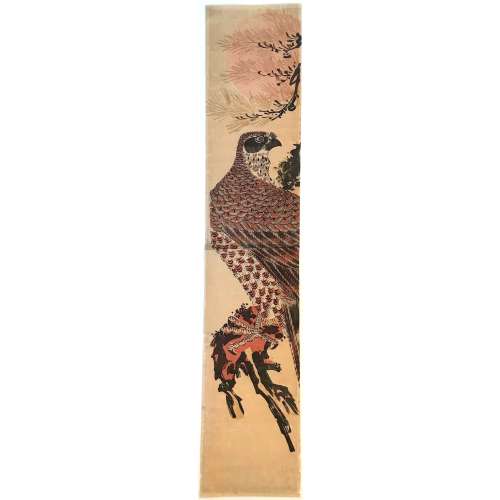 The print lacks signature. It is attributed by some to Suzuki Harunobu and by the others to Isoda Koryūsai.
The print lacks signature. It is attributed by some to Suzuki Harunobu and by the others to Isoda Koryūsai.Attributed to Koryūsai: Pins #517/p.209, c. 1775 [AIC II: Clarence Buckingham Collection, 1925.2772], Ukiyo-e Taisei IV; Vignier & Inada, 1911; Ritsumeikan University Z0165-239.
Attributed to Harunobu: Pins #239/p.132.; BM 1906,1220,0.85;
-
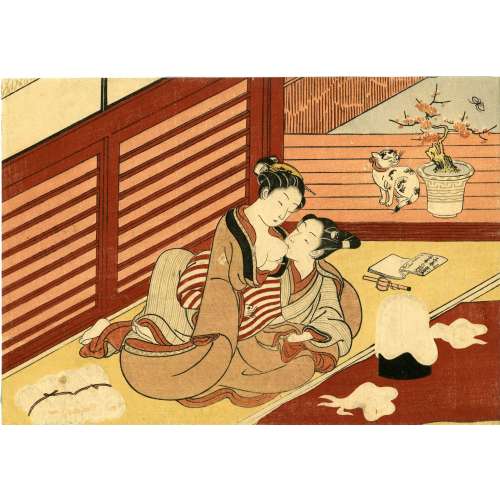 Artist (attributed, no signature): Suzuki Harunobu [鈴木 春信] (Japanese, c. 1725 – 1770). The title is taken from [LIB-1478.2013] Gian Carlo Calza, Stefania Piotti. Poem of the pillow and other stories. — Phaidon Press, 2010; pp. 148-9. Alternative title: Man sucking woman's breast and a cat sitting under a bonsai tree. The open book beside the couple reads 子春 (Koharu). Woodblock print from the series Mirror Picture of Japan (Wakoku kagami); Size: Horizontal chuban; 21 x 26 cm.
Artist (attributed, no signature): Suzuki Harunobu [鈴木 春信] (Japanese, c. 1725 – 1770). The title is taken from [LIB-1478.2013] Gian Carlo Calza, Stefania Piotti. Poem of the pillow and other stories. — Phaidon Press, 2010; pp. 148-9. Alternative title: Man sucking woman's breast and a cat sitting under a bonsai tree. The open book beside the couple reads 子春 (Koharu). Woodblock print from the series Mirror Picture of Japan (Wakoku kagami); Size: Horizontal chuban; 21 x 26 cm. -
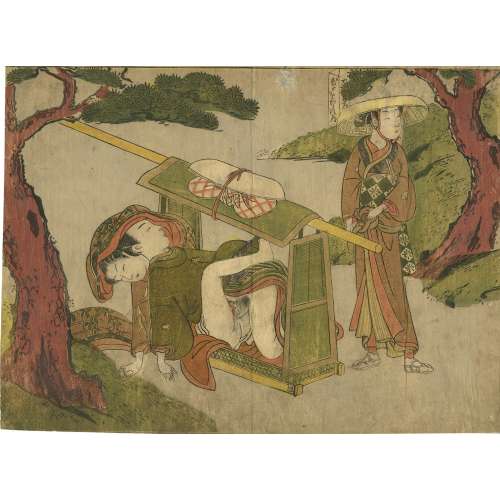 A shunga (erotic) print by Suzuki Harunobu [鈴木 春信] (Japanese, c. 1725 – 1770) depicting a woman making love with a man in the palanquin (のりもの/乗り物) while the other woman "ties a sash about her hips below her obi." The sheet is not signed; however, it is attributed to Harunobu. A reference image can be found in the Metropolitan Museum (NY) collection, Accession Number JP1635:According to the MET "the palanquin ... has carried these courtesans to the shore for a spring outing". Some time ago, a similar print was sold by Richard Kruml (description: A chuban shunga print showing the occupant of a kago in flagrante with one of the porters, having seized the opportunity of a stop on the journey. Published late 1760s. Rare). Another copy was sold at Sotheby's in Paris for €3,360 on November 27, 2002 (Lot 24), with a reproduction of the print's detail and description on p. 39: Suzuki Harunobu (1725 – 1770) | Shunga: couple dans un palanquin, vers 1768-1770, non-signe, cachet non identifé, cachets Charles Mitchell, Huguette Berès, Format chuban, 20.1 x 28.6 cm | 3000 – 4000 € | Il s’agit probablement de trois voyageurs, l’un d’entre eux debout près du palanquin faisant mine d’ignorer la scène. Bibliographie: Delay p. 87. Reference: [LIB-3121.2022] Sotheby's: Collection Huguette Berès – Estampes, dessins et livres illustrés japonais / 2 volumes; vol. 1. — Paris: Sotheby's, 2002.
A shunga (erotic) print by Suzuki Harunobu [鈴木 春信] (Japanese, c. 1725 – 1770) depicting a woman making love with a man in the palanquin (のりもの/乗り物) while the other woman "ties a sash about her hips below her obi." The sheet is not signed; however, it is attributed to Harunobu. A reference image can be found in the Metropolitan Museum (NY) collection, Accession Number JP1635:According to the MET "the palanquin ... has carried these courtesans to the shore for a spring outing". Some time ago, a similar print was sold by Richard Kruml (description: A chuban shunga print showing the occupant of a kago in flagrante with one of the porters, having seized the opportunity of a stop on the journey. Published late 1760s. Rare). Another copy was sold at Sotheby's in Paris for €3,360 on November 27, 2002 (Lot 24), with a reproduction of the print's detail and description on p. 39: Suzuki Harunobu (1725 – 1770) | Shunga: couple dans un palanquin, vers 1768-1770, non-signe, cachet non identifé, cachets Charles Mitchell, Huguette Berès, Format chuban, 20.1 x 28.6 cm | 3000 – 4000 € | Il s’agit probablement de trois voyageurs, l’un d’entre eux debout près du palanquin faisant mine d’ignorer la scène. Bibliographie: Delay p. 87. Reference: [LIB-3121.2022] Sotheby's: Collection Huguette Berès – Estampes, dessins et livres illustrés japonais / 2 volumes; vol. 1. — Paris: Sotheby's, 2002.
http://www.metmuseum.org/art/collection/search/45071
-
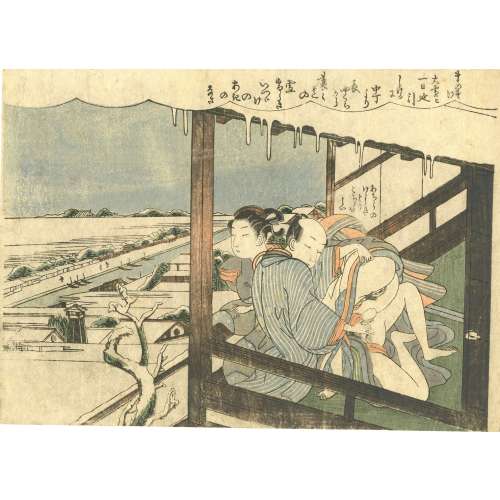 Unsigned print, attributed to Suzuki Harunobu. Erotic scene on open veranda with a winter landscape on background.
Unsigned print, attributed to Suzuki Harunobu. Erotic scene on open veranda with a winter landscape on background. -
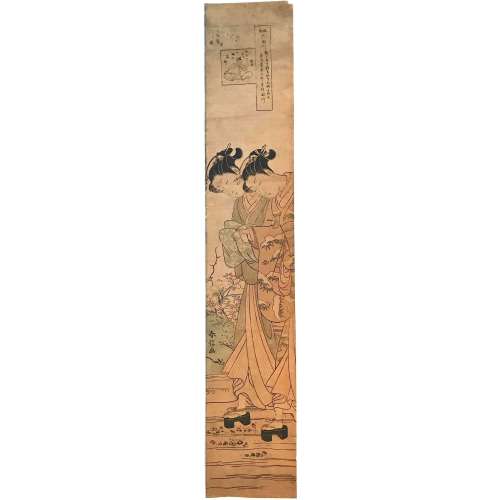 Suzuki Harunobu (鈴木 春信; c. 1725 – 15 July 1770).
Suzuki Harunobu (鈴木 春信; c. 1725 – 15 July 1770).The Ide Jewel River, a Famous Place in Yamashiro Province (Ide no Tamagawa, Yamashiro no meisho), from the series The Six Jewel Rivers in Popular Customs (Fûzoku Mu Tamagawa).
Signed: Harunobu gaInscription - Poem: Koma tomete/ nao mizu kawan/ yamabuki no/ hana no tsuyu sou/ Ide no Tamagawa
References:MFA # 21.4540.
Waterhouse cat. #562; Pins, The Japanese Pillar Print (1982), #139; Ukiyo-e shûka 4 (1979), list #795.4, and supp. 2 (1982), pl. 565; Gentles, AIC cat. II (1965), p. 125, #201.
-
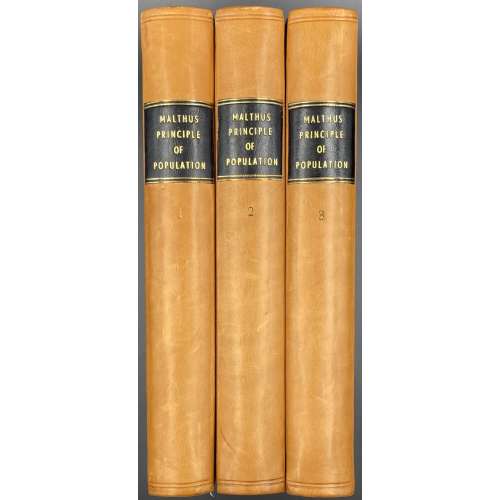 Title: AN ESSAY | ON THE | PRINCIPLE OF POPULATION; | OR, | A VIEW OF ITS PAST AND PRESENT EFFECTS | ON | HUMAN HAPPINESS; | WITH | AN INQUIRY INTO OUR PROSPECTS RESPECTING THE FUTURE | REMOVAL OR MITIGATION OF THE EVILS WHICH | IT OCCASIONS | BY T. R. MALTHUS, A. M. | Late Fellow of Jesus College, Cambridge, and Professor of History and Political Economy in the East-India College, Hertfordshire. | IN THREE VOLUMES. | VOL. I. [or II. or III.] | THE FIFTH EDITION, | WITH IMPORTANT ADDITIONS. | LONDON: | JOHN MURRAY, ALBEMARLE-STREET. | 1817. || Pagination and collation: Vol. 1: ffl, [i, ii] – t. p. / imprint., [iii] iv-xvi, [1] 2-496, bfl; A-Z8 2A-2I8. Vol. 2: ffl, [i, ii] – t. p. / imprint., [iii]-iv – contents, [1]-2-507 [508], bfl; [A]2 B-Z8 2A-2I8 2K6. Vol. 3: ffl, [i, ii] – t. p. / imprint., [iii]-iv – contents, [1]-2-500, bfl; [A]2 B-Z8 2A-2I8 2K2. Binding: Three volumes printed on wove paper, uniformly bound in quarter brown polished calf, blind-ruled, black label, ruled and lettered in gilt to spine, green buckram boards; 22.2 x 13.5 cm. Edition: 5th edition, corrected with a new preface, an updated appendix of Malthus’ responses to his critics, and addition of several chapters to the whole: on France, England, and on the poor laws. Lifetime edition. Ref.: Einaudi 3670; Goldsmiths’ 21761; Kress B.6974; Mattioli 2210. Printed by W. Clowes: William Clowes Ltd. (London). Clowes, William (British, 1779 – 1847). Malthus, Thomas Robert (British, 1766 – 1834). Murray, John (British, 1737 – 1793) Murray, John II (British, 1778 – 1843) John Murray (publishing house)
Title: AN ESSAY | ON THE | PRINCIPLE OF POPULATION; | OR, | A VIEW OF ITS PAST AND PRESENT EFFECTS | ON | HUMAN HAPPINESS; | WITH | AN INQUIRY INTO OUR PROSPECTS RESPECTING THE FUTURE | REMOVAL OR MITIGATION OF THE EVILS WHICH | IT OCCASIONS | BY T. R. MALTHUS, A. M. | Late Fellow of Jesus College, Cambridge, and Professor of History and Political Economy in the East-India College, Hertfordshire. | IN THREE VOLUMES. | VOL. I. [or II. or III.] | THE FIFTH EDITION, | WITH IMPORTANT ADDITIONS. | LONDON: | JOHN MURRAY, ALBEMARLE-STREET. | 1817. || Pagination and collation: Vol. 1: ffl, [i, ii] – t. p. / imprint., [iii] iv-xvi, [1] 2-496, bfl; A-Z8 2A-2I8. Vol. 2: ffl, [i, ii] – t. p. / imprint., [iii]-iv – contents, [1]-2-507 [508], bfl; [A]2 B-Z8 2A-2I8 2K6. Vol. 3: ffl, [i, ii] – t. p. / imprint., [iii]-iv – contents, [1]-2-500, bfl; [A]2 B-Z8 2A-2I8 2K2. Binding: Three volumes printed on wove paper, uniformly bound in quarter brown polished calf, blind-ruled, black label, ruled and lettered in gilt to spine, green buckram boards; 22.2 x 13.5 cm. Edition: 5th edition, corrected with a new preface, an updated appendix of Malthus’ responses to his critics, and addition of several chapters to the whole: on France, England, and on the poor laws. Lifetime edition. Ref.: Einaudi 3670; Goldsmiths’ 21761; Kress B.6974; Mattioli 2210. Printed by W. Clowes: William Clowes Ltd. (London). Clowes, William (British, 1779 – 1847). Malthus, Thomas Robert (British, 1766 – 1834). Murray, John (British, 1737 – 1793) Murray, John II (British, 1778 – 1843) John Murray (publishing house) -
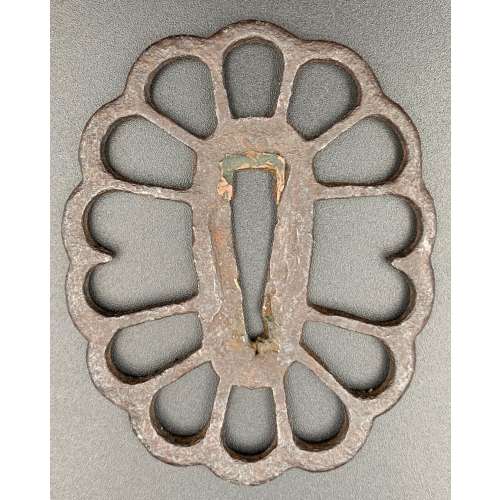
Iron tsuba with chrysanthemum design in openwork (sukashi). Copper sekigane.
Late Heian through Kamakura period (ca. 1150 - 1200's).
Size: 78.4 x 60.9 x 3.5 mm; weight: 45.7 g
Provenance: Boris Markhasin Message from Boris Markhasin (13-AUG-2019): It is a very rudimentary tachi tsuba, and the iron is old and really nothing to draw attention. However, this is a very old tsuba, and that is what makes it very special and an important study piece. This tsuba likely dates to the late Heian through Kamakura (ca. 1150 - 1200's) -- by consensus, since such examples are extremely rare, and none are mounted to my knowledge, so few direct analogues. The form is interesting for a variety of reasons. The smaller size, an oval form is associated more with 12th/13th c styles. The sukashi kiku motif is very interesting as it clearly pushes back the dating of large scale sukashi far back in time. This shouldn't be surprising, but for some reason, we (really mainly westerners) naively tend to associate sukashi with the Muromachi and younger. The two missing spokes are by consensus likely later removals to accommodate kozuka and kogai -- but this is not certain, and it could be an original styling. A key kantei point is the elongate, narrow, slightly squared seppa dai. This is a characteristic of early koshirae, which were much thinner and more delicate than the types we are used to seeing that date pretty much to the late Muromachi and later. I am always amazed when I have a chance to interrogate early koshirae at how thin they are - I want to call them fragile, but they were actually quite resilient. The walls were super thin, but the top and bottom edges were a bit thicker, providing a bit of structural support... but this is another thread topic. Of all the tsuba I have owned, this is the tsuba that has most clearly reflected the shape of the old style of saya / tsuka. -
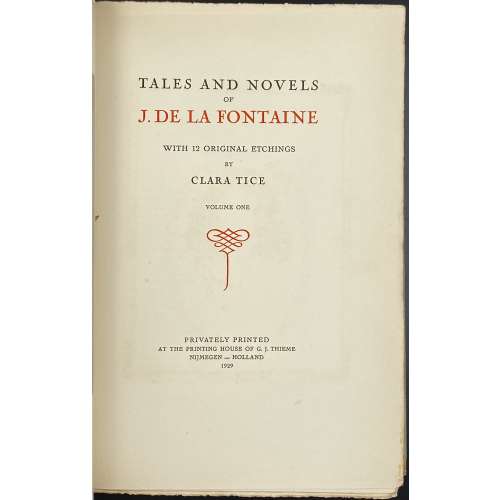 Title-page (in red and black): TALES AND NOVELS | OF | J. DE LA FONTAINE | WITH 12 ORIGINAL ETCHINGS | BY | CLARA TICE | VOLUME ONE (TWO) | {arabesque} | PRIVATELY PRINTED | AT THE PRINTING HOUSE OF G. J. THIEME | NIJMEGEN ~ HOLLAND | 1929 || Collation: 8vo. Vol. 1: π8 (2 blanks, h.t. / limitation №103 of 990, frontispiece etched portrait of La Fontaine w/ tissue guard, 4 leaves uncut with table and preface), 1—138, incl. 2 final blanks, paginated: xvi, 204 [4], plus 5 etchings besides frontis., all with tissue guards, by Clara Tice, in sepia. Vol. 2: π8, 1-188, paginated: xvi, 270 [271] epitaph, [272] blank, plus 6 etchings w/ tissue guards, by Clara Tice. Binding: 25.3 x 16.8 cm, quarter faux parchment over light blue publisher's boards, gilt lettering to spine. Ticket to front pastedown in each volume: “FROM THE COLLECTION | OF PRINCETON ANTIQUES BOOKFINDERS”, etc. Etchings printed on wove paper, text – on laid paper; untrimmed, uncut. Edition: limited, privately printed run of 990 copies of which this is №103.
Title-page (in red and black): TALES AND NOVELS | OF | J. DE LA FONTAINE | WITH 12 ORIGINAL ETCHINGS | BY | CLARA TICE | VOLUME ONE (TWO) | {arabesque} | PRIVATELY PRINTED | AT THE PRINTING HOUSE OF G. J. THIEME | NIJMEGEN ~ HOLLAND | 1929 || Collation: 8vo. Vol. 1: π8 (2 blanks, h.t. / limitation №103 of 990, frontispiece etched portrait of La Fontaine w/ tissue guard, 4 leaves uncut with table and preface), 1—138, incl. 2 final blanks, paginated: xvi, 204 [4], plus 5 etchings besides frontis., all with tissue guards, by Clara Tice, in sepia. Vol. 2: π8, 1-188, paginated: xvi, 270 [271] epitaph, [272] blank, plus 6 etchings w/ tissue guards, by Clara Tice. Binding: 25.3 x 16.8 cm, quarter faux parchment over light blue publisher's boards, gilt lettering to spine. Ticket to front pastedown in each volume: “FROM THE COLLECTION | OF PRINCETON ANTIQUES BOOKFINDERS”, etc. Etchings printed on wove paper, text – on laid paper; untrimmed, uncut. Edition: limited, privately printed run of 990 copies of which this is №103. -
![[ROSCOE, Thomas, translator]. Tales of Humour, Gallantry, & Romance, selected and translated from the Italian. With sixteen illustrative Drawings by George Cruikshank. London, Printed for Charles Baldwyn, 1827.](https://varshavskycollection.com/wp-content/uploads/2021/02/LIB-1079-2-scaled-500x500.jpg) Title: TALES | OF | Humour, Gallantry, & Romance, | SELECTED AND TRANSLATED | FROM THE ITALIAN. | Vignette "The Elopement, p. 183" | With sixteen illustrative Drawings by George Cruikshank. | — | LONDON : | PRINTED FOR CHARLES BALDWYN, | NEWGATE STREET. | MDCCCXXVII. Pagination: [2], [v]-vi [2] – Contents (Cohn's collation calls for this at the end) 3-253, [1]; title-page a cancel with vignette 'The Elopment', sixteen other plates by Cruikshank; as per HathiTrust: vi, 253, [3] p. (last p. blank), [16] leaves of plates: ill. Binding: 8vo, 20 x 13 cm, later polished calf, gilt, t.e.g. others untrimmed, by Rivière for H. Sotheran. Note: 1st edition, very rare 3rd issue, with a cancel title-page replacing that of 1824 issue when there were two issues and the work was entitled Italian Tales. Cohn notes the rarity of the 1827 edition, which restores one of the plates 'The Dead Rider', suppressed in the second issue, and also includes the plate done to replace it. "The rarest edition of this work is that published in 1827 in green paper boards [...]. This issue has no edition stated on the title. It has seventeen woodcuts, inclusive of the "Elopement" vignette upon the title. The suppressed plate "The Dear Rider" is restored, and the plate done to replace it is also included. The woodcut in other editions upon the title page is "The Pomegranate Seed". Probably compiled and translated by Thomas Roscoe (cf. National union catalog) from a variety of authors 'out of materials not generally accessible', but also ascribed to J. Y. Akerman and to one "Southern". Two or three tales that furnished plots for Shakespeare. Catalogue Raisonné: Cohn 444; this issue not found in OCLC or COPAC.
Title: TALES | OF | Humour, Gallantry, & Romance, | SELECTED AND TRANSLATED | FROM THE ITALIAN. | Vignette "The Elopement, p. 183" | With sixteen illustrative Drawings by George Cruikshank. | — | LONDON : | PRINTED FOR CHARLES BALDWYN, | NEWGATE STREET. | MDCCCXXVII. Pagination: [2], [v]-vi [2] – Contents (Cohn's collation calls for this at the end) 3-253, [1]; title-page a cancel with vignette 'The Elopment', sixteen other plates by Cruikshank; as per HathiTrust: vi, 253, [3] p. (last p. blank), [16] leaves of plates: ill. Binding: 8vo, 20 x 13 cm, later polished calf, gilt, t.e.g. others untrimmed, by Rivière for H. Sotheran. Note: 1st edition, very rare 3rd issue, with a cancel title-page replacing that of 1824 issue when there were two issues and the work was entitled Italian Tales. Cohn notes the rarity of the 1827 edition, which restores one of the plates 'The Dead Rider', suppressed in the second issue, and also includes the plate done to replace it. "The rarest edition of this work is that published in 1827 in green paper boards [...]. This issue has no edition stated on the title. It has seventeen woodcuts, inclusive of the "Elopement" vignette upon the title. The suppressed plate "The Dear Rider" is restored, and the plate done to replace it is also included. The woodcut in other editions upon the title page is "The Pomegranate Seed". Probably compiled and translated by Thomas Roscoe (cf. National union catalog) from a variety of authors 'out of materials not generally accessible', but also ascribed to J. Y. Akerman and to one "Southern". Two or three tales that furnished plots for Shakespeare. Catalogue Raisonné: Cohn 444; this issue not found in OCLC or COPAC. -
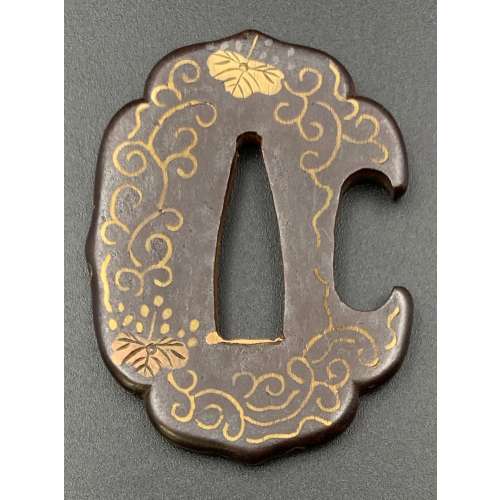
Small iron tsuba (tantō size) of aoi form with the design of paulownia leaves and blossoms in copper and brass flat inlay (hira-zōgan). Brass sekigane. Open kozuka hitsu-ana.
Early Edo period, 17th century.
Size: 53.4 x 40.7 x 4.4 mm; weight: 47.4 g
-
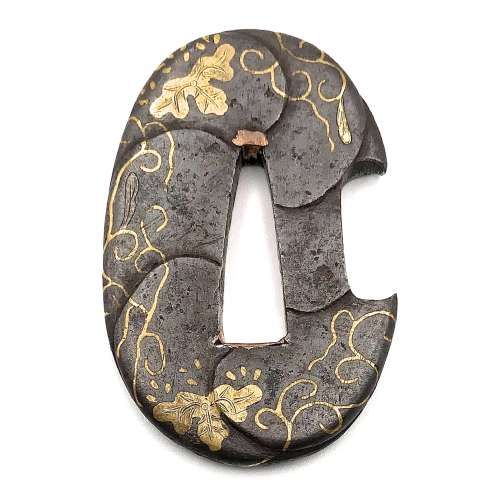
Small iron tsuba (tantō size) of oval form carved with imitation of six overlapping plates, decorated with paulownia blossoms, leaves, and tendrils in brass and copper hira-zōgan. Copper sekigane. Open kozuka hitsu-ana.
Early Edo period, 17th century.
Size: 50.5 x 34.0 x 4.9 mm.
-
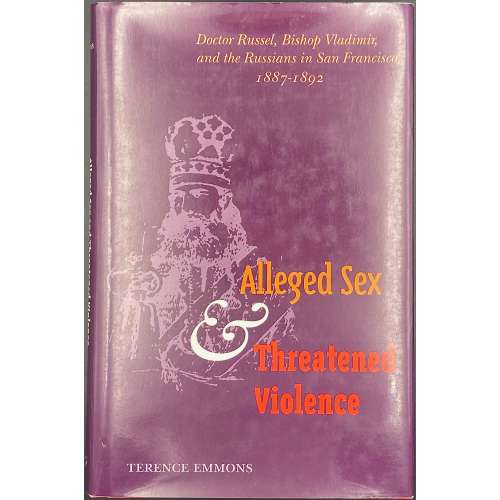 Hardcover volume, 22.5 x 15 cm, bound in red cloth with gilt lettering to spine, pictorial dust jacket; pp.: [i-v] vi-xiv, [1-5] 6-251 [252], total 268 pages. Title-page: Alleged sex and threatened violence | Doctor Russel, Bishop Vladimir, and the Russians in | San Francisco, 1887-1892 | TERENCE EMMONS | — | Stanford University Press | Stanford, California | 1977 || ISBN: 9780804727679, 9780804727686, 0804727678, 0804727686. OCLC Number / Unique Identifier: 35159156. Doctor Nikolai Sudzilovsky [Nicholas Russel] (Belarusian, 1850 – 1930). Bishop Vladimir (Sokolovsky-Avtonomov, Vasily Grigorievich) Архиепископ Владимир (Соколовский-Автономов, Василий Григорьевич) (Russian, 1852 – 1931) – Archbishop of the Aleutians and Alaska.
Hardcover volume, 22.5 x 15 cm, bound in red cloth with gilt lettering to spine, pictorial dust jacket; pp.: [i-v] vi-xiv, [1-5] 6-251 [252], total 268 pages. Title-page: Alleged sex and threatened violence | Doctor Russel, Bishop Vladimir, and the Russians in | San Francisco, 1887-1892 | TERENCE EMMONS | — | Stanford University Press | Stanford, California | 1977 || ISBN: 9780804727679, 9780804727686, 0804727678, 0804727686. OCLC Number / Unique Identifier: 35159156. Doctor Nikolai Sudzilovsky [Nicholas Russel] (Belarusian, 1850 – 1930). Bishop Vladimir (Sokolovsky-Avtonomov, Vasily Grigorievich) Архиепископ Владимир (Соколовский-Автономов, Василий Григорьевич) (Russian, 1852 – 1931) – Archbishop of the Aleutians and Alaska. -
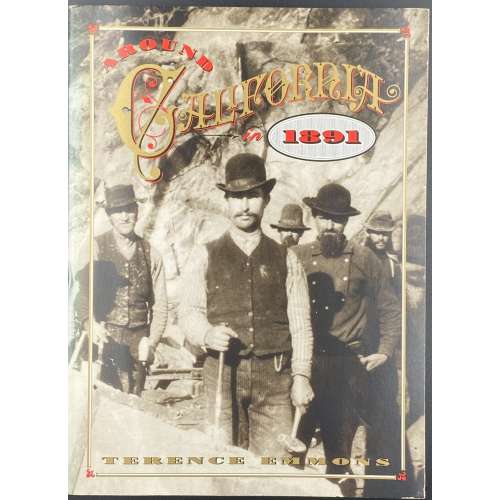 Softcover, 22.5 x 16.5 cm, pictorial paperback, pp.: [i-xi] xii-xix [xx blank] [2] [1] 2-179 [180] [6 advert.], total 206 pp plus cardstock Portable Stanford form. Nicholas Russel [Николай Константинович Судзиловский] (Russian-American, 1850 – 1930)
Softcover, 22.5 x 16.5 cm, pictorial paperback, pp.: [i-xi] xii-xix [xx blank] [2] [1] 2-179 [180] [6 advert.], total 206 pp plus cardstock Portable Stanford form. Nicholas Russel [Николай Константинович Судзиловский] (Russian-American, 1850 – 1930) -
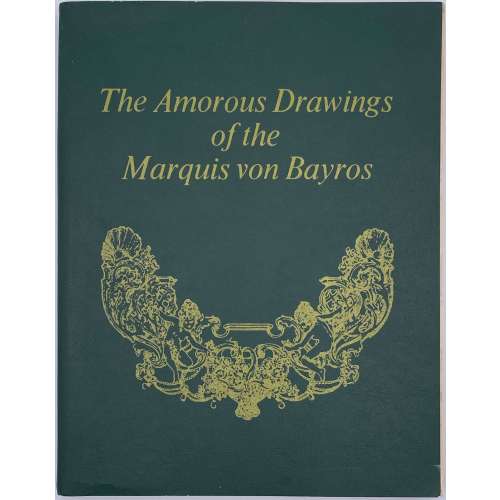 Title: The amorous drawings | {vignette} | of the | Marquis von Bayros | Part I | BRANDON HOUSE | NORTH HOLLYWOOD || Title page verso: A BRANDON HOUSE BOOK | PUBLISHED BY ARRANGEMENT WITH | CYTHERA PRESS | COPYRIGHT 1968 BY CYTHERA PRESS | ALL RIGHTS RESERVED. | MANUFACTURED IN THE UNITED STATES OF AMERICA || Pagination: [1-3] 4-238 [2], 292 illustrations within pagination. Content: Preface by Wilhelm M. Busch, biography of Von Bayros by Johann Pilz, two essays by Von Bayros; 292 illustrations by Marquis Franz von Bayros; Part I and II in one volume. Exterior: 28 x 22 cm, publisher's green wrappers with yellow lettering and fac-simile drawing of von Bayros to cover, lettering to spine. A re-print softcover edition of the original Cythera Press 1st edition, see: LIB-2246.2019
Title: The amorous drawings | {vignette} | of the | Marquis von Bayros | Part I | BRANDON HOUSE | NORTH HOLLYWOOD || Title page verso: A BRANDON HOUSE BOOK | PUBLISHED BY ARRANGEMENT WITH | CYTHERA PRESS | COPYRIGHT 1968 BY CYTHERA PRESS | ALL RIGHTS RESERVED. | MANUFACTURED IN THE UNITED STATES OF AMERICA || Pagination: [1-3] 4-238 [2], 292 illustrations within pagination. Content: Preface by Wilhelm M. Busch, biography of Von Bayros by Johann Pilz, two essays by Von Bayros; 292 illustrations by Marquis Franz von Bayros; Part I and II in one volume. Exterior: 28 x 22 cm, publisher's green wrappers with yellow lettering and fac-simile drawing of von Bayros to cover, lettering to spine. A re-print softcover edition of the original Cythera Press 1st edition, see: LIB-2246.2019 -
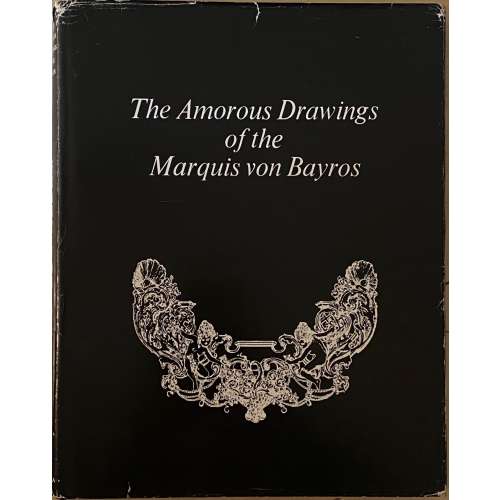 Title: The amorous drawings | of the | Marquis von Bayros | Part I | THE CYTHERA PRESS | NEW YORK Pagination: [1-3] 4-238 [2], 292 illustrations within pagination. Content: Preface by Wilhelm M. Busch, biography of Von Bayros by Johann Pilz, two essays by Von Bayros; 292 illustrations by Marquis Franz von Bayros; Part I and II in one volume. Exterior: 33 x 26 cm, publisher's black cloth with white lettering and fac-simile drawing of von Bayros to cover, white lettering to spine, similarly designed DJ. The original Cythera Press hardcover edition of 1968.
Title: The amorous drawings | of the | Marquis von Bayros | Part I | THE CYTHERA PRESS | NEW YORK Pagination: [1-3] 4-238 [2], 292 illustrations within pagination. Content: Preface by Wilhelm M. Busch, biography of Von Bayros by Johann Pilz, two essays by Von Bayros; 292 illustrations by Marquis Franz von Bayros; Part I and II in one volume. Exterior: 33 x 26 cm, publisher's black cloth with white lettering and fac-simile drawing of von Bayros to cover, white lettering to spine, similarly designed DJ. The original Cythera Press hardcover edition of 1968. -
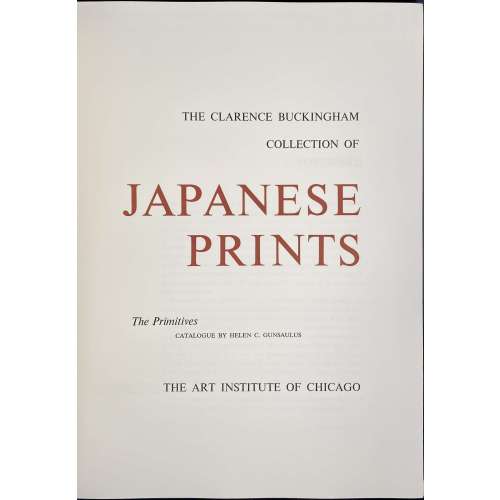 Two volumes, each bound in red cloth with gilt lettering to spine, black endpapers, TEG, and matching red cloth slipcases with black lettering to front. Vol. 1: The Clarence Buckingham collection of Japanese prints: The Primitives / Catalogue by Helen C. Gunsaulus. — [Chicago]: Art Institute of Chicago, 1955. Pagination: 1st leaf blank, 2nd leaf half-title, verso blank, [i, ii] – t.p. in red and black, copyright to verso, iii-vi, [vii] faux-title “The catalogue”, 1-284 [285] colophon, limitation: 500 numbered copies, this is № 476. Title-page: THE CLARENCE BUCKINGHAM | COLLECTION OF | JAPANESE PRINTS | The Primitives | CATALOGUE BY HELEN C. GUNSAULUS | THE ART INSTITUTE OF CHICAGO || Vol. 2: The Clarence Buckingham collection of Japanese prints: Volume 2 / Catalogue by Margaret O. Gentles. — [Chicago]: Art Institute of Chicago, 1965. Pagination: 1st leaf blank, 2nd leaf half-title, verso blank, [i, ii] – t.p. in red and black, copyright to verso, iii-vi, [vii] faux-title “The catalogue”,1-307 [2] blank/ colophon, limitation: 1000 copies (unnumbered). Title-page: VOLUME II | THE CLARENCE BUCKINGHAM | COLLECTION OF | JAPANESE PRINTS | Harunobu, Koryūsai, Shigemasa, their followers and contemporaries | Catalogue by Margaret O. Gentles | THE ART INSTITUTE OF CHICAGO 1965 || Contributors: Clarence Buckingham (American, 1854 – 1913) Helen C. Gunsaulus (American, 1886 – 1954) Margaret O. Gentles (American, 1905 – 1969)
Two volumes, each bound in red cloth with gilt lettering to spine, black endpapers, TEG, and matching red cloth slipcases with black lettering to front. Vol. 1: The Clarence Buckingham collection of Japanese prints: The Primitives / Catalogue by Helen C. Gunsaulus. — [Chicago]: Art Institute of Chicago, 1955. Pagination: 1st leaf blank, 2nd leaf half-title, verso blank, [i, ii] – t.p. in red and black, copyright to verso, iii-vi, [vii] faux-title “The catalogue”, 1-284 [285] colophon, limitation: 500 numbered copies, this is № 476. Title-page: THE CLARENCE BUCKINGHAM | COLLECTION OF | JAPANESE PRINTS | The Primitives | CATALOGUE BY HELEN C. GUNSAULUS | THE ART INSTITUTE OF CHICAGO || Vol. 2: The Clarence Buckingham collection of Japanese prints: Volume 2 / Catalogue by Margaret O. Gentles. — [Chicago]: Art Institute of Chicago, 1965. Pagination: 1st leaf blank, 2nd leaf half-title, verso blank, [i, ii] – t.p. in red and black, copyright to verso, iii-vi, [vii] faux-title “The catalogue”,1-307 [2] blank/ colophon, limitation: 1000 copies (unnumbered). Title-page: VOLUME II | THE CLARENCE BUCKINGHAM | COLLECTION OF | JAPANESE PRINTS | Harunobu, Koryūsai, Shigemasa, their followers and contemporaries | Catalogue by Margaret O. Gentles | THE ART INSTITUTE OF CHICAGO 1965 || Contributors: Clarence Buckingham (American, 1854 – 1913) Helen C. Gunsaulus (American, 1886 – 1954) Margaret O. Gentles (American, 1905 – 1969) -
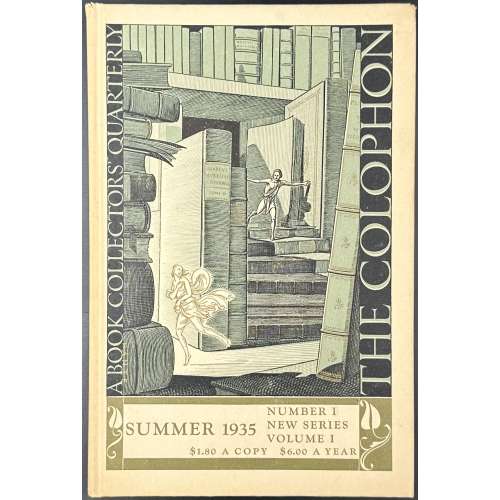
The Colophon, A Book Collectors' Quarterly
- The colophon (new series): A quarterly for bookmen / Summer 1935, № 1, vol. 1. — NY: Pynson Printers, 1935. Hardcover, 24 x 16 cm, paper boards, serial pictorial design; pp: [4 blanks] [6] 7-159 [160] [4 blanks]. THE | COLOPHON | new series | A QUARTERLY FOR BOOKMEN | {woodcut vignette} | — | SUMMER 1935 | VOLUME I • NEW SERIES • NUMBER 1 | NEW YORK, N. Y. ||
- The colophon (new series): A quarterly for bookmen / Autumn 1935, № 2, vol. 1. — NY: Pynson Printers, 1935. (2 copies). Hardcover, 24 x 16 cm, paper boards, serial pictorial design; pp: [4 blanks] [6] 167-315 [315] [4 blanks]. THE | COLOPHON | new series | A QUARTERLY FOR BOOKMEN | {woodcut vignette} | — | AUTUMN 1935 | VOLUME I • NEW SERIES • NUMBER 2 | NEW YORK ||
- The colophon (new series): A quarterly for bookmen / Autumn 1936, № 1, vol. 2. — NY: Pynson Printers, 1936. Hardcover, 24 x 16 cm, cloth serial design; pp: [4 blanks] [6] 7-157 [158] [4 blanks]. THE | COLOPHON | new series | A QUARTERLY FOR BOOKMEN | {woodcut vignette} | — | AUTUMN 1936 | VOLUME II • NEW SERIES • NUMBER 1 | NEW YORK ||
- The colophon (new series): A quarterly for bookmen / Winter 1936, № 3, vol. 1. — NY: Pynson Printers, 1936. (2 copies) Hardcover, 24 x 16 cm, paper boards, serial pictorial design; pp: [4 blanks] [6] 323-480 [4 blanks]. THE | COLOPHON | new series | A QUARTERLY FOR BOOKMEN | {woodcut vignette} | — | WINTER 1936 | VOLUME I • NEW SERIES • NUMBER 3 | NEW YORK ||
- The colophon (new series): A quarterly for bookmen / Autumn 1937, № 4, vol. 2. — NY: Pynson Printers, 1937. Hardcover, 24 x 16 cm, cloth serial design; pp: [4 blanks] [6] 487-628 [4 blanks]. THE | COLOPHON | new series | A QUARTERLY FOR BOOKMEN | {woodcut vignette} | — | AUTUMN 1937 | VOLUME II • NEW SERIES • NUMBER 4 | NEW YORK ||
- The colophon (new series): A quarterly for bookmen / Summer 1938, № 3, vol. 3. — NY: Pynson Printers, 1938. Hardcover, 24 x 16 cm, cloth new serial design; pp: [4 blanks] [6] 335-476 [4 blanks]. THE | COLOPHON | new series | A QUARTERLY FOR BOOKMEN | {woodcut vignette} | — | SUMMER 1938 | VOLUME III • NEW SERIES • NUMBER 3 | NEW YORK ||
- The colophon (new series): A quarterly for bookmen / Autumn 1938, № 4, vol. 3. — NY: Pynson Printers, 1938. Hardcover, 24 x 16 cm, cloth new serial design; pp: [4 blanks] [6] 483-632 [4 blanks]. THE | COLOPHON | new series | A QUARTERLY FOR BOOKMEN | {woodcut vignette} | — | AUTUMN 1938 | VOLUME III • NEW SERIES • NUMBER 4 | NEW YORK ||
-
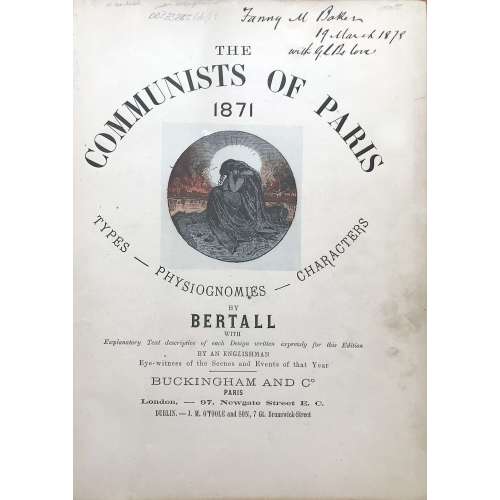 Folio (246 x 321 mm), hardbound in red-brown cloth with gilt lettering and decoration. Content, Introduction by J. E., September, 1873, Artist preface by Bertall, Paris, 1871-1873. Album with 40 hand-colored lithographs by Bertall, numbered 1 through 40, accompanied with extensive descriptions. Ex Libris: Baker. Carpe Diem. Markings: Janny M. Baker with J.L.B. Love, 19 March, 1878 in black ink.
Folio (246 x 321 mm), hardbound in red-brown cloth with gilt lettering and decoration. Content, Introduction by J. E., September, 1873, Artist preface by Bertall, Paris, 1871-1873. Album with 40 hand-colored lithographs by Bertall, numbered 1 through 40, accompanied with extensive descriptions. Ex Libris: Baker. Carpe Diem. Markings: Janny M. Baker with J.L.B. Love, 19 March, 1878 in black ink.


